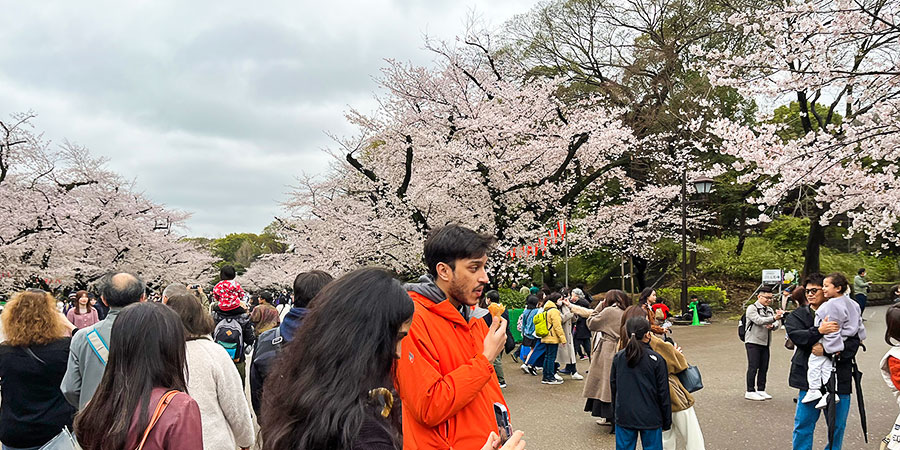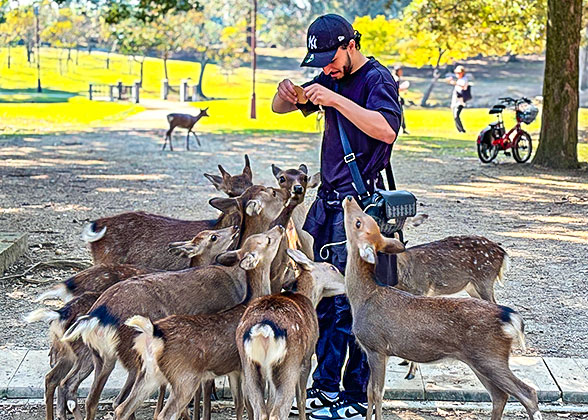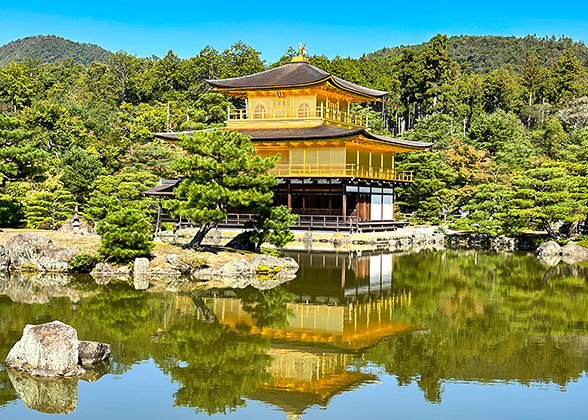Ueno Park
Ueno Park, also known as Ueno Onshi-Koen, is the best place to appreciate cherry blossoms in Tokyo. Opened as early as in 1873, it is also the oldest park in Japan, hence containing not only beautiful natural attractions, but also varied cultural sites and art museums. Among them, the most famous are Ueno Zoo, Shinobazu Pond, Tokyo National Museum, The National Museum of Western Art, and Kaneiji.Best Place to See Cherry Blossoms in Tokyo
The cherry blossoms is the most famous scene of Ueno Park. More than 1,200 cherry trees make Ueno Park the best place to appreciate cherry blossoms in Tokyo, attracting millions of people each year. From late March to early April is the best time for you to appreciate cherry blossoms. During this period, Ueno Park will hold the Cherry Blossom Festival, and 1,000 candlelights will be hung during the night. Its main road, where gathers about half of the park’s cherry trees, is the best site for cherry blossoms appreciation. In general, Japanese geisha rarely conduct a show in public. Fortunately, you may see Japanese geisha performance during the Cherry Blossom Festival period.
![]() Opening Hours & Ticket Price: You can take a walk in the park for free, between 5:00 and 21:00.
Opening Hours & Ticket Price: You can take a walk in the park for free, between 5:00 and 21:00.
![]() Read more: What Months are Cherry Blossom Season in Japan?
Read more: What Months are Cherry Blossom Season in Japan?

Ueno Park Photos ( 10
|
What Others to See in Ueno Park
1. Ueno Zoo
Ueno Zoo is the oldest zoo in Japan, opened in 1882, including nearly 350 species and 2,500 animals, such as Sumatran tigers, Western lowland gorillas, South American tapirs, and polar bears. The panda is the star animal of the zoo. The majority of animals are energetic in the morning, so visiting the zoo as early as possible can make you see more lively animals. If you take children, Children's Zoo STEP is a good choice. There are many animals from the African continent gathered here, such as rhinoceros, hippos, giraffes, and zebras. In addition, kids can see small houses displaying small mammals and amphibious reptiles.
![]() Notes: *Tickets are available till 16:00.
Notes: *Tickets are available till 16:00.
|
|
|
2. Shinobazu Pond
Shinobazu Pond is a huge natural pond, covering nearly 110,000 ㎡ (27 acres), about two football fields in size, known for its lotus flowers. July and August are the best time to appreciate the lotus flowers. Between 7 am and 9 am, you can take a boat to float on the pond while listening to the music, and appreciating blooming lotus flowers. In the center of the pond, you also can see a temple called Bentendo, featuring an octagonal palace. The temple worships one of the seven lucky gods, Benzaiten, who is the patron saint of music and art. Besides, there are a large number of wild black swans, mandarin ducks, geese, and other birds inhabiting here. You also can see nearly 600 species of aquatic animals in the 4-storey aquarium on the lakeside.

Shinobazu Pond in Autumn
|
3. Toshogu Shrine
Toshogu Shrine, also known as “Gloden Hall”, was established in 1627 to worship a famous Japanese general, Tokugawa Ieyasu. Many visitors pray for passing examinations, successful careers, and longevity in the shrine. The best time to visit there is May, when one can appreciate peony blossoms inside.
![]() Tickets: Free of Charge
Tickets: Free of Charge
|
|
|
4. Tokyo National Museum
Tokyo National Museum established in 1872, the oldest museum in Japan, owns about 120,000 collections, of which 89 are national treasures and 648 are important cultural properties of Japan. Exhibits include Japanese tea sets, ukiyo-e, kabuki costumes, and samurai equipment. It contains six pavilions, namely Honkan (Japanese Gallery), Heiseikan (Japanese Archaeology and Special Exhibition), Toyokan (Asian Gallery), The Gallery of Horyuji Treasures, Kuroda Memorial Hall, and Hyokeikan. Hyokeikan itself is an important cultural property, and it was established in 1909, combining Japanese and Western building styles. If you are interested in Chinese culture, Toyokan is a must-visit. For instance, you can see Chinese ancient calligraphy works.Notes: *Kuroda Memorial Hall is closed at 17:00 all year.
![]() Tickets: 1,000 Yen; People under the age of 18 and over the age of 70 are free of charge. Notes: * Tickets are available till 16:00.
Tickets: 1,000 Yen; People under the age of 18 and over the age of 70 are free of charge. Notes: * Tickets are available till 16:00.
|
|
|
5. The National Museum of Western Art
The National Museum of Western Art was designed by French architect Le Corbusier, combining Western art and Japanese art. In 2016, the National Museum of Western Art was listed as a World Heritage Site. The main building of the museum shows a fauvism style of architecture. The museum collects over 6,000 artworks, including Rodin's sculpture “The Thinker” and Monet's painting “Water Lilies”.6. Tokyo Metropolitan Art Museum
In 1926, as the first public art museum, the Tokyo Metropolitan Art Museum opened in Japan. It contains four Citizen's Gallery, which basically shows the Japanese modern art style and traditional Japanese ukiyo-e. There are nearly 300 exhibitions held each year, and items are varied at different times. Each Friday, it will hold a special exhibition.Notes: * Special exhibitions are not free, and a ticket basically costs 2,000 yen.
7. National Museum of Nature and Science
In the National Museum of Nature and Science, ancient dinosaur skeletons, steam engines, and high-technology 3D films are must-sees. These items witnessed the change and development of ages. In the Earth Gallery, there are more than 100 animal specimens, including those of tigers, bears, gorillas, and camels. Japan Gallery is a permanent exhibition, which displays content about Japanese history, culture, nature…*Special exhibitions are charged extra.
8. Kaneiji
Kaneiji is a famous Buddhist temple established in the 1625. Six of the Tokugawa generals in the past are now buried here.9. Bronze Statue of Saigo Takamori, a Famous Japanese Samurai
The bronze statue of Saigo Takamori is another representative symbol of the park. As one of the most famous and brave samurai, Saigo Takamori is known to most Japanese. Samurai spirit is the traditional and basic mental vision of the Japanese army, which reflects the strong willpower of Japanese soldiers.How to Get to Ueno Park
Ueno Park is within the walking distance from Ueno Station, a transportation hub which can be easily reached by public transport.
From Tokyo City:
1. Take JR Tokyo Metro Ginza Line or Hibiya Line, get off at Ueno Station, leave from JR Ueno Park exit and you will see the entrance to the park.2. Take Capital Line, get off at Capital Ueno Station.
From Narita Airport:
Take Keisei Skyliner from Narita Airport, get off at Ueno Station.
From Other Cities by Train:
Take JR Yamanote Line, get off at Ueno Station.Recommended Time for a Visit
Suppose you only want to visit the basic landscape of the park, half a day is enough. However, it is worth spending all day to visit other interior attractions. Since the majority of attractions are closed on Mondays, so you can choose other date.Nearby Attractions
Sensoji Temple, a Buddhist temple, is the most famous temple in Tokyo. From Ueno Park, you can take metro Ginza line to get there and it takes about 10 minutes. Besides, you can visit the Nakamise-dori Street near the temple.Akihabara is the main shopping area for video games, anime, manga, electronics, and computer-related productions. From Ueno Park, you can take the metro Hibiya Line to get there and it takes about 18 minutes.
Ueno Park Photos & more Tokyo Photos




